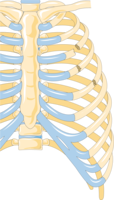Rib fracture
| Rib fracture | |
|---|---|
| Other names | Broken rib, cracked rib |
opioids[2] | |
| Prognosis | Pain improves over 6 weeks[3] |
| Frequency | Common[2] |
A rib fracture is a
Rib fractures usually occur from a direct blow to the chest such as during a
Signs and symptoms
This typically results in chest pain that is worse with inspiration.
Complications
When several ribs are broken in several places a flail chest results.[4] Potential complications include a pneumothorax, pulmonary contusion, and pneumonia.[2][1]
Causes
Rib fractures can occur with or without direct trauma during recreational activity. Cardiopulmonary resuscitation (CPR) has also been known to cause thoracic injury, including but not limited to rib and sternum fractures. They can also occur as a consequence of diseases such as cancer or rheumatoid arthritis. While for elderly individuals a fall can cause a rib fracture, in adults automobile accidents are a common event for such an injury.[11]
Diagnosis
Signs of a broken rib may include:[12]
- Pain on inhalation
- Swelling in chest area
- Bruise in chest area
- Increasing shortness of breath
- Coughing up blood (rib may have damaged lung)
Plain
Because children have more flexible chest walls than adults do, their ribs are more likely to bend than to break; therefore the presence of rib fractures in children is evidence of a significant amount of force and may indicate severe thoracic injuries such as pulmonary contusion.[4] Rib fractures are also a sign of more serious injury in elderly people.[14]
-
Illustration showing rib fracture at 3rd, 4th and 5th rib
-
Right sided pneumothorax and rib fractures
-
Two broken ribs as seen on parasagittal CT
Treatment
There is no specific treatment for rib fractures, but various supportive measures can be taken. In simple rib fractures, pain can lead to reduced movement and cough suppression; this can contribute to formation of secondary chest infection.
Nerve blocks
Nerve blocks may be used to help with pain and reduce respiratory complications related to rib fractures.
Surgery
Treatment options for internal fixation/repair of rib fractures include:
- Judet and/or sanchez plates/struts are a metal plate with strips that bend around the rib and then is further secured with sutures.[24]
- There are different specialist rib fixation systems on the market. They have two options: a precontoured metal plate that uses screws to secure the plate to the rib; and/or an intramedullary splint which is tunneled into the rib and secured with a set screw.[25]
- Anterior locking plates are metal plates that have holes for screws throughout the plate. The plate is positioned over the rib and screwed into the bone at the desired position. The plates may be bent to match the contour of the section.[26]
- U-plates can also be used as they clamp on to the superior aspect of the ribs using locking screws.[27]
See also
References
- ^ ISBN 978-0323112581. Archivedfrom the original on 2017-10-13.
- ^ .
- ^ ISBN 978-1455733941. Archivedfrom the original on 2017-10-13.
- ^ PMID 14979330.
- ISBN 978-3-642-24698-2.
- S2CID 23442272.)
{{cite journal}}: CS1 maint: numeric names: authors list (link - S2CID 45547470.
- PMID 27572897.
- PMID 27482027.
- PMID 27894495.
- ^ Rib Fracture at eMedicine
- ^ "Broken or bruised ribs". NHS.UK. 2015. Archived from the original on 20 August 2015. Retrieved 15 August 2015.
- ^ PMID 28958357.
- PMID 19026224.
- PMID 16936230.
- ISBN 9780781799898. Archivedfrom the original on 2016-06-29.
- S2CID 251206240.
- PMID 31091512.
- S2CID 35082310.
- ISBN 9780190630478.
- S2CID 210194417.
- S2CID 221328812.[permanent dead link]
- S2CID 237400070.
- PMID 21841954.
- ISBN 978-1-46988-903-0. Archived from the original on 12 May 2016. Retrieved 15 August 2015.Rib fracture at Google Books
- ISBN 978-1416022206. Archivedfrom the original on 2016-05-08.
- S2CID 11113635.



